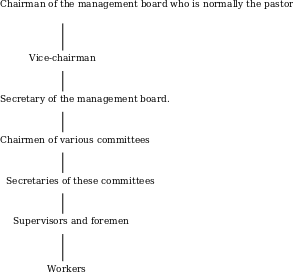Introduction
Organizational structures have evolved over time from simple forms to very sophisticated types. They have been refined through experience and experimentation. They have adopted scientific management theories that have made the theme compatible with the modern technological world. Various people such as F. Taylor were instrumental in this development. These systems contribute to the wellbeing of the society through various means, for example, they bring together resources in order to accomplish a society’s needs, help to facilitate innovation, they facilitate easy accommodation of ongoing cultural, social, economical, and economic changes, they control and monitor the development of consumer goods and services, they foster communities’ participation In the process of development and also control the use of resources.
The church uses a functional structure to group people and resources. It groups people together because they hold similar positions in the church. They perform a similar set of tasks and use the same kind of skills.

Why the organization uses this form of structure
It facilitates easy communication among the people involved. People are grouped together according to their abilities and they can communicate and share information. They are grouped vertically according to their specialization and horizontally according to their level of qualification. The structure facilitates quick decision-making because the approach to problems is from the same perspective.
Learning is made easier since employees can learn from each anthers experience. This helps the employees to improve their skills and thereby enhancing individual and organizational performance (Don, 1999). This structure has a greater motivational advantage. Supervisors are in a good position to monitor individual performance, motivate the employees to give their best, and discourage social laxity.
The members monitor and control each other’s behavior and performance since teamwork spirit is developed. The hard-working employees can be promoted to a higher level or position. Yes, another structure with appropriate stratification of position would still be appropriate and would produce even more desirable results. A different structure may bring into play various advantages that the functional system does not have. It may also help overcome the shortcomings of the functional system.
In the organization’s structure, there are seven levels.

The organization has the right number of levels because the duties are well shared throughout the structure. The authority is decentralized among the various secretaries and the chairmen in the management. However, the management board reserves the right to pass major decisions and formulate the laws.
The organization always uses mutual adjustment and standardization to coordinate its activities. It has rules set that are used to govern its activities. In cases where adjustments are required, they are done in accordance with the church’s own constitution. The constitution provides guidance on what should be done and when it should be done. Teams or cross-functional teams are normally formed to perform specific functions when there is a need for their formation. However, they are normally dissolved after the completion of the stated task (Shivgansen & Beena1992). The church uses rules and regulations formulated by the management board as provided for by the church’s constitution.
Conclusion
The development and evolution of human societies is a continuous process. Societies become complex and sophisticated with time. This calls for continued refining of organization systems and structures in order to ensure proper management of our scarce resources. Churches are instruments of change and thus should also participate in the refining of such systems to ensure the development of perfect systems. Organization structure and culture influences the employees or workers behaviors, motivation teamwork, performances and relations.
References
Don, S “(1999) Structural problems suppress incorporated accomplishment.” promotion News, 33. American Marketing Association.
Shivgansen & Beena. (1992) calculation of Organizational success as a utility of a managerial Structure.” Social Psychology Journal , 132. Heldref Publications.